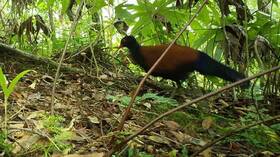Scientists from the American Bird Conservancy have rediscovered a rare bird belonging to the pheasant or partridge family, the pheasant pigeon, that had not been documented for nearly 140 years.
Scientists set up camera traps for this bird on Ferguson Island in Papua New Guinea, and the results showed the presence of a rare black-necked pheasant-dove waving in the pictures.
The pheasant pigeon is a “large, ground-dwelling pigeon” with a “broad, side-tucked tail” that lives only on islands off the east coast of Papua New Guinea, according to the American Bird Conservancy.
The photos and video of the bird represent the first time this bird has been scientifically documented since 1882.
The bird, a black-necked pheasant pigeon, has not been documented since 1882. Researchers in Papua New Guinea captured the first photograph of the animal. pic.twitter.com/qUIZdlLgbg
— USA TODAY (@USATODAY) 21 November 2022
Seeing the footage “is the dream moment of your entire life as a conservationist and birdwatcher,” said John C. Mittermeier, director of the Lost Birds Program at the American Bird Conservancy and co-leader of the science expedition.
We are excited to finally share our exciting news!
Stay tuned for videos showing our full month of dramatic searches for this elusive species.
For now, enjoy the first photo and video of the long-lost Black Neck Pheasant pigeon. https://t.co/8QC121GDTopic.twitter.com/rlcofNGonn
– Jordan Boersma (@Jordan_Boersma) November 17, 2022
“He was surprised by this image of a bird walking right next to the camera,” said Jordan Bursma, a postdoctoral researcher at Cornell University and co-leader of the expedition team, adding that he realized it was there when it was set up. the cameras. . less than 1 percent chance of hitting Take a photo of a black-necked pheasant pigeon.
“This rediscovery is an incredible sign of hope for other birds that have been lost for half a century or more,” said Christina Biggs, director of extinct species research at Re:wild , an environmental movement dedicated to helping nature heal itself.
Roger Safford, Director of BirdLife International’s Extinction Prevention Program, said: “Apart from giving hope to the search for other extinct species, the detailed information gathered by the team has provided a foundation for the conservation of extremely rare this bird, which should be critically endangered. unique species.
Source: ScienceAlert
Source: Arabic RT
